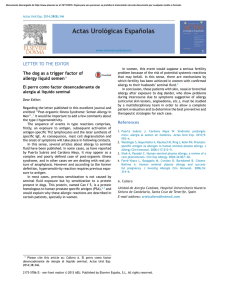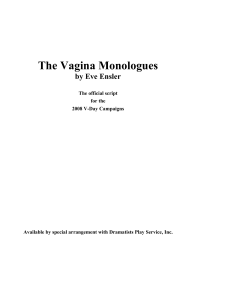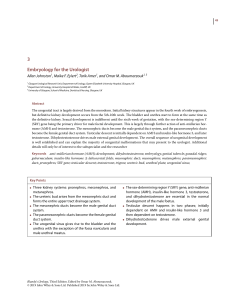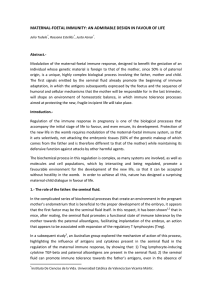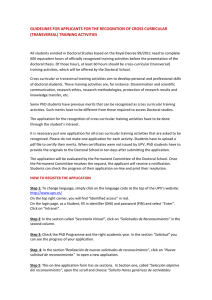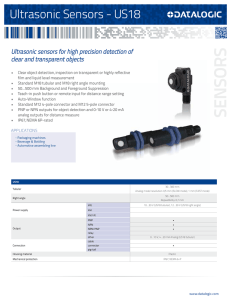ANATOMY AND HISTOLOGY OF THE FEMALE REPRODUCTIVE
Anuncio
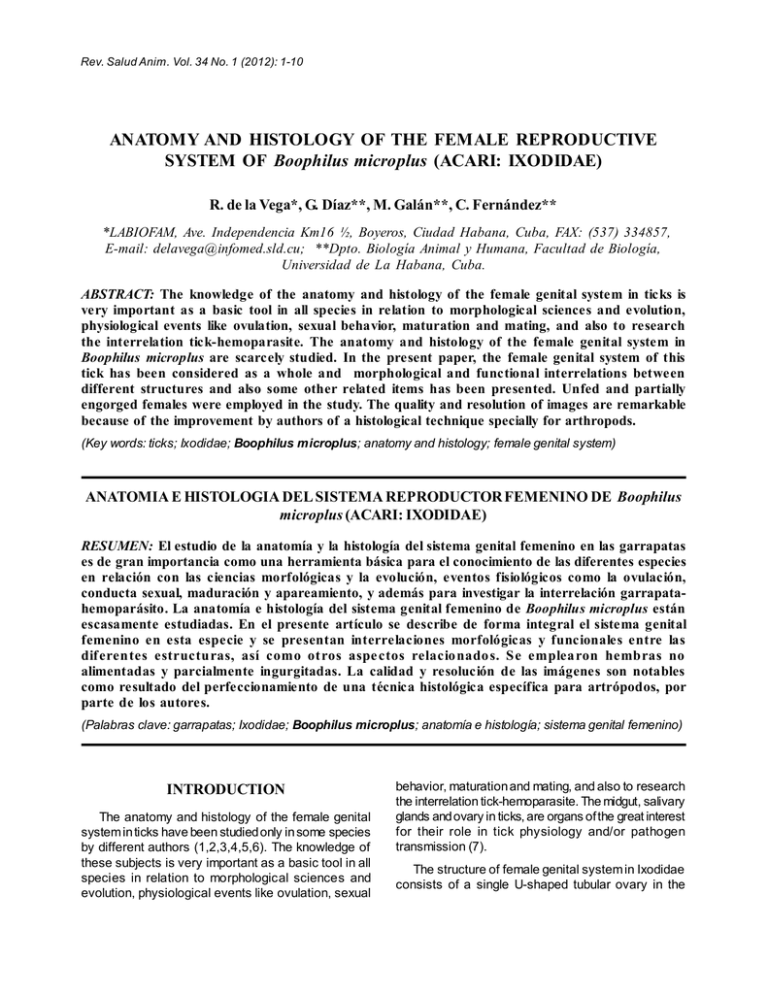
Rev. Salud Anim. Vol. 34 No. 1 (2012): 1-10 ANATOMY AND HISTOLOGY OF THE FEMALE REPRODUCTIVE SYSTEM OF Boophilus microplus (ACARI: IXODIDAE) R. de la Vega*, G. Díaz**, M. Galán**, C. Fernández** *LABIOFAM, Ave. Independencia Km16 ½, Boyeros, Ciudad Habana, Cuba, FAX: (537) 334857, E-mail: delavega@infomed.sld.cu; **Dpto. Biología Animal y Humana, Facultad de Biología, Universidad de La Habana, Cuba. ABSTRACT: The knowledge of the anatomy and histology of the female genital system in ticks is very important as a basic tool in all species in relation to morphological sciences and evolution, physiological events like ovulation, sexual behavior, maturation and mating, and also to research the interrelation tick-hemoparasite. The anatomy and histology of the female genital system in Boophilus microplus are scarcely studied. In the present paper, the female genital system of this tick has been considered as a whole and morphological and functional interrelations between different structures and also some other related items has been presented. Unfed and partially engorged females were employed in the study. The quality and resolution of images are remarkable because of the improvement by authors of a histological technique specially for arthropods. (Key words: ticks; Ixodidae; Boophilus microplus; anatomy and histology; female genital system) ANATOMIA E HISTOLOGIA DEL SISTEMA REPRODUCTOR FEMENINO DE Boophilus microplus (ACARI: IXODIDAE) RESUMEN: El estudio de la anatomía y la histología del sistema genital femenino en las garrapatas es de gran importancia como una herramienta básica para el conocimiento de las diferentes especies en relación con las ciencias morfológicas y la evolución, eventos fisiológicos como la ovulación, conducta sexual, maduración y apareamiento, y además para investigar la interrelación garrapatahemoparásito. La anatomía e histología del sistema genital femenino de Boophilus microplus están escasamente estudiadas. En el presente artículo se describe de forma integral el sistema genital femenino en esta especie y se presentan interrelaciones morfológicas y funcionales entre las diferentes estructuras, así como otros aspe ctos relacio nado s. Se emplea ron hembras no alimentadas y parcialmente ingurgitadas. La calidad y resolución de las imágenes son notables como resultado del perfeccionamiento de una técnica histológica específica para artrópodos, por parte de los autores. (Palabras clave: garrapatas; Ixodidae; Boophilus microplus; anatomía e histología; sistema genital femenino) INTRODUCTION The anatomy and histology of the female genital system in ticks have been studied only in some species by different authors (1,2,3,4,5,6). The knowledge of these subjects is very important as a basic tool in all species in relation to morphological sciences and evolution, physiological events like ovulation, sexual behavior, maturation and mating, and also to research the interrelation tick-hemoparasite. The midgut, salivary glands and ovary in ticks, are organs of the great interest for their role in tick physiology and/or pathogen transmission (7). The structure of female genital system in Ixodidae consists of a single U-shaped tubular ovary in the 2 posterior region of the body, paired and folded oviducts are in both extremes of the ovary joint into a common oviduct or uterus. The uterus opens into the vagina, which is divided in a cervical vagina and a vestibular vagina. A seminal receptacle, absent in argasids (3,4) as well as the uterus, open also in the cervical vagina. A pair of tubular accessory glands pours out their secretions at the level of the union of both cervical and vestibular vagina. Surrounding the vestibular vagina there is a glandular epithelium, the lobular accessory gland, found only in ixodid ticks (4). RESULTS AND DISCUSSION GENERAL SCHEME OF F EMAL E GENITAL STRUCTURE Figure 1 shows a general scheme of the principal organs that form the female genital system of B. microplus, in a lateral view, based on the mentioned papers and present results. As all schemes, it is a generalization froma number of individuals; reader ought to keep in mind that variations The anatomy and histology of the female genital system in Boophilus microplus are scarcely studied; only it is possible to refer to articles about oviducts and fertilization (8,9) and studies of the ovary by Saito et al. (10). In the present paper, the general objective is to consider the female genital system of this tick as a whole and to analyze the morphological and functional interrelations between different structures. Also, the mating process in the species is approached and the semen transport inside the female´s tract is shown. The quality and resolution of images are remarkable because of the improvement by authors of a histological technique specially for arthropods FIGURE 1. B. microplus female genital system scheme: lateral view./ and for the employ of an original procedure for Esquema del sistema genital femenino: vista lateral. feminine tract dissection that makes it easier and saves time avoiding technical complications. in each item fromdifferent specimens are actually a very frequent fact. Figure 2 represents the same scheme 1 with vertical lines demarcating zones, in order to guide MATERIALS AND METHODS readers on the approximate location of a number of serial Procedures: Histological and dissection Techniques: cuts. So, next photographs will represent an approach of the anatomical location of these shown structures in The histological technique of Schneider and relation to these conventional lines. Rudinsky (11) modified by de la Vega and Fernández (12) was used, to accomplish good results the inicial technique needs from 8 to 9 days, whereas that present demands only from 8 to 9 hours and images retain the same quality. Coloration was done with hematoxylineosine. A vertical microtome was used; tissue thickness of 3-5μ was achieved. Some serial slicing were performed transversely and other longitudinally in horizontal or in sagittal sense, this procedure permits a better comprehension of three-dimensional disposition of organs inside the arthropod. Dissection of tick specimens was performed with an original method (13) allowing a faster and secure procedure that could be done in 10 to 15 minutes per tick with a great percentage of success and without loss of genital structure parts. Ticks: Unfed and partially engorged females of B. microplus, before or after mating, were employed in the study. Rev. Salud Anim. Vol. 34 No. 1 (2012) FIGURE 2. General scheme with vertical lines guiding reader about locations of cuts./ Esquema general con líneas verticales como guía para la localización de los cortes. 3 Ovary, oviducts, seminal receptacle and tubular accessory glands obtained by dissection of non-fed and fed, unmated and mated females are shown in Figures 3-5. FIGURE 3. Ovary, oviducts, seminal receptacle and tubular accessory glands, obtained by dissection of a non-fed female./ Ovario, oviductos, receptáculo seminal, glándulas accesorias tubulares, obtenidos por disección de una hembra no alimentada. 16X Ovary: The histological structure of ovary with oocytes and pedicel cells is shown in figures 6 and 7. The ovary is composed by a layer of small epithelial cells with rounded nuclei surrounding the lumen, and oocytes in different developmental stages: I, II, III, IV and V (10), attached through the pedicel cells to the ovarian wall. Also, the degenerative stage VI has been described (5,10). Cells very similar to the epithelial ones form the pedicels. Pedicel cells holding oocytes I and II stages are cylindric with large elliptic nuclei occupying most of the cytoplasm, there are numerous round mitochondria as well as rough endoplasmic reticulum, instead, pedicel cells attaching oocytes IV a nd V s how si gns o f dege ne ra ti o n (14 ). I n Rhipicephalus sanguineus, de Oliveira et al. (15) considered that there are three probable sources of elements for the oocytes’ growth: an endogenous one, through synthesis processes inside the oocyte, and two exogenous ones: the haemolymph and the pedicel cells. Results of studies in Amblyomma triste by de Oliveira et al. (16) suggest that besides the exogenous production of vitellogenic elements, endogenous ovary lumen pedicel FIGURE 4. Extreme of an ovary and oviduct beginning, by dissection, in a non-fed female./ Extremo del ovario e inicio del oviducto, por disección, en una hembra no alimentada. 25X tubular accessory gland endospermatophore inside a seminal receptacle FIGURE 5. A close up of ovary extremes, oviducts,a full seminal receptacle and a tubular accessory gland,by dissection, in a fed and mated female./ Un acercamiento a los extremos del ovario, oviductos, receptáculo seminal lleno y una glándula tubular accesoria, por disección, en una hembra que se alimentó y copuló. 25X FIGURE 6. Transversal section of the ovary. Relationship between pedicel cells and oocytes is clearly exposed./ Sección transversal del ovario. Se aprecia la relación entre las células pedicelares y los oocitos. 560X ovary lumen pedicel oocyte FIGURE 7. Another view of ovary, pedicels and oocytes./ Otra vista del ovario, pedicelos y oocitos. 560X Rev. Salud Anim. Vol. 34 No. 1 (2012) 4 production can take place simultaneously contributing to the development and growth of the oocytes. tubular accessory gland Central structures of female genital system cervical vagina Oviducts: in both endings of the ovary there are two thin folded tubes, in B.microplus the diameter of oviducts oscillated between 75 and 140µ in females feed up to 48 hours; they fuse under the seminal receptacle to form the common oviduct or uterus. Uterus: It is in communication with the cervical vagina by means of an epithelial folded muscular tube: the connecting tube (Fig. 8). In the cervical vagina (Fig. 9), besides the uterus, the seminal receptacle, tubular accessory glands (TAG) and the vestibular v agina converge. There are some anatomical particularities in B.microplus that are evident when sections obtained in this tick (Fig. 9) are compared with schemes of other species like Rhipicephalus appendiculatus and Hyalomma asiaticum (1,3). In R. appendiculatus and H. asiaticum, the cervical vagina is very developed, the debouchment of the seminal receptacle and the uterus form an angle of 180° and are relatively distant one from the other. On the contrary, in B. microplus, the cervical vagina is very little, the debouchment of the seminal receptacle and the uterus in the mentioned vagina form an angle less than 90° and the seminal receptacle is completely above the ut erus. Thi s f act co uld fa cilita te the wa y f or spermiophores to found the course toward the oviducts and ovary. folded epithelium circulatory sinus muscular layer FIGURE 8. A close-up of connecting tube (between cervical vagina and uterus) near line 2./ Un acercamiento al tubo de conexión (entre la vagina cervical y el útero) cerca de la línea 2. 400X Rev. Salud Anim. Vol. 34 No. 1 (2012) seminal receptacle vestibular vagina oviduct uterus FIGURE 9. Sagittal cut involving vestibular vagina, cervical vagina, tubular accessory gland, empty seminal receptacle, empty uterus and an oviduct debouching in the uterus./ Corte sagital que interesa la vagina vestibular, vagina cervical, glándula tubular accesoria, receptáculo seminal vacío, útero vacío y un oviducto desembocando en el útero. 200X An anatomical view of one of TAG is shown in Fig. 5, and longitudinal and transversal histological views of one of these glands are presented in Fig. 10 and 11. In the female fixed for six days to the host and with 24 hours with a male near it, these glands have a length of 540µ and 90µ of wide. The vestibular vagina: in a sagittal histological cut (Fig. 12), it is seen that it extends from the genital pore to the cervical vagina. Also, the sagittal sections, and in close up of the genital pore and the final part of the vestibular vagina can be seen in Fig. 13, 14, 15. The lobular accessory gland is also shown in Fig 12; it is an enlargement of the vestibular vaginal epithelium which produces a secretion for the initial waterproofing layer for the eggs and also it is the most likely source of the genital sex pheromone (4, 17). Transversal sections of vestibular vagina appear in Fig. 16-18, they show that this structure is irregular in shape along it. Next transversal cuts (Fig. 19-22) show images of the central part of the genital organs. In these images, all structures seem to be surrounded by circulatory sinus (in fact they were never shown in images of B. microplus). It is conspicuous the likeness of the images in all photographs and this fact discards the possibility of being a histological technic artifact. 5 brain vestibular vagina genital pore FIGURE 10. Sagittal cut of a tubular accessory gland./ Corte sagital de una glándula tubular accesoria. 240X FIGURE 13. Sagittal section, in close up with the distal part of the vestibular vagina and the genital pore./ Sección sagital, en un acercamiento de la porción distal de la vagina vestibular y el poro genital. 250X genital pore FIGURE 11. Transversal cut of a tubular accessory gland./ Corte transversal de una glándula tubular accesoria. 350X operculum FIGURE 14. Transversal cut (a close up) made throught the genital pore line 1./ Sección transversal, con acercamiento a nivel del poro genital línea 1. 250X lobular accessory gland vestibular vagina vagina genital pore lobular accessory gland FIGURE 12. Sagittal cut of the vestibular vagina and its lobular accessory gland, view of the genital pore./ Corte sagital de la vagina vestibular y su glándula lobular accesoria, vista del poro genital. 230X FIGURE 15. Section made near line 1, it begins to be apparent the lobular accessory gland./ Corte realizado cerca de la línea 1, comienza a apreciarse la glándula lobular accesoria. 275X Rev. Salud Anim. Vol. 34 No. 1 (2012) 6 epithelium lobular accessory gland tubular accessory gland seminal receptacle perioviductal sinus sinus connecting tube vagina FIGURE 16. Transversal cut made between lines1 and 2./ Corte transversal realizado entre las líneas 1 y 2. 200 X FIGURE 19. Transversal cut between lines 2 and 3, different sinus are seen surrounding seminal receptacle, oviducts, connecting tube and tubular glands./ Corte transversal entre las líneas 2 y 3, se aprecian diferentes senos rodeando el receptáculo seminal, oviductos, tubo de conexión y glándulas tubulares. 200X tubular accessory gland oviducts seminal receptacle lobular accessory gland uterus vagina FIGURE 17. Transversal cut made between lines 1 and 2./ Corte transversal realizado entre las líneas 1 y 2. 200 X FIGURE 20. Transversal cut of oviducts, seminal receptacle, uterus and tubular accessory glands. It seems that all these structures are surrounded by vascular sinus, this image is situated between lines 2 and 3./ Corte transversal de oviductos, receptáculo seminal, útero y glándulas tubulares accesorias. Al parecer todas estas estructuras están rodeadas por senos vasculares, esta imagen está situada entre las líneas 2 y 3. 125X lobular accessory gland seminal receptacle uterus vagina FIGURE 18. Transversal cut between lines 1 and 2./ Corte transversal entre las líneas 1 y 2. 200 X Rev. Salud Anim. Vol. 34 No. 1 (2012) FIGURE 21. This histological cut passed near line 4./ Corte histológico que pasó cerca de la línea 4. 125 X 7 When oviposition begins, the swollen structure is projected forward by hydrostatic pressure, the fingerlike processes are everted from the body (4). In Fig. 24, it can be appreciated an everted Gené’s organ through the camerostomal fold just before oviposition begins. Gené’s organ deposits wax on each egg as it is delivered from the vagina. The wax coat waterproofs the eggs and causes them to stick together (17) forming huge masses that also contribute to retard desiccation. FIGURE 22. This is scraping the end of both, uterus and seminal receptacle cut made near or between lines 4 and 5./ Corte rozando el extremo distal del útero y el receptáculo seminal cercano a la línea 4 o entre las líneas 4 y 5. 125 X Gené’s organ: It is an organ only observed in ticks, it is located in the interior of the body cavity near the anterior end of the scutum (2,4). It is a paired structure formed by globular or finger like sacs sometimes called horns and glandular tissue. Different authors (1,2,3,4) have made a full description of this organ. When not in use, the organ is retracted within the anterior region of the body near the capitulum. In Fig. 23, a transversal cut can be appreciated at the cheliceral level, a horn and glandular tissue of the Gené’s organ can be seen. FIGURE 24. Two horns of Gené’s organ have protruded through the camerostomal fold just before oviposition./ Dos cuernos del órgano de Gené proyectados a través del pliegue camerostomal justamente antes del inicio de la oviposición. 15X Copula and semen transport Male climbs over the back of the female and then slide down beneath the couple looking for the genital pore (18,19) and put itself venter to venter with the female, grasping it with its legs (Fig. 25). The male chelicerae sheat pharynx digestive cells Gene´s organ salivary glands gland FIGURE 23. Tranversal cut through the capitulum, chelicerae with their sheats, the doble Y form of pharynx is also seen and some salivary glands and elements of Gené ’s organ: two horns and one of the glandular structures./ Corte transversal a través del capitulum, quelíceros con sus vainas, se aprecia la doble Y característica de la faringe y algunas glándulas salivares y elementos del órgano de Gené: dos cuernos y una de las estructuras glandulares. 220X FIGURE 25. A couple of B. microplus in mating./ Pareja de B. microplus en posición de cópula. 12X Rev. Salud Anim. Vol. 34 No. 1 (2012) 8 bends its capitulum toward the female genital aperture and then introduces its chelicerae which protrude out of its shafts into the female genital pore (18,19, 20); both hypostome and palps briefly touch the surface of the female, receptors on the palps mediate pheromone perception, these sensilla are concentrated on the fourth segment of the palp on hard ticks (20). A detail study of mating and sexual tick behavior could be read in Kiszewski et al. (20). Male introduces its chelicerae inside the female genital pore and then ejaculates into a sac, named ectospermatophore; inside it , there is another sac the endospermatophore full of inmature seminal cells named s pe rmat ids. The male ta ke s the ectospermatophore with its chelicerae by the neck of the sac and introduces it into the female genital pore (18). In Fig. 26, a female with the ectospermatophore hanguing from the genital pore can be seen, it is a weak union, and for this reason, it is not frequent to see it. The ectospermatophore is pear-like in shape and the maximum diameter oscillates between 400500µ in this tick. The endospermatophore has a rounded shape (350-400 µ) with two appendices, one greater than the other one. These two appendices have been also described in other ticks and are characteristic of Ixodidae, whereas in Argasidae, there is only one (18). Spermatids suffer a capacitation inside the seminal receptacle in order to complete maturation; already mature cells are called spermiophores (Fig. 27, 28, 29, 30). The minimum time required after the copula is performed is seven days. When sexual cells are already mature, the endospermatophore´s wall breaks down and spermiophores form a compact packet passing into the uterus (Fig. 31). Finally in Fig. 32, it can be seen how spermiophores are released inside the feminine tract. It has been suggested (9) that fertilization takes place in the internal cylinder which extends from the uterus to the ovary itself. seminal receptacle TAG endospermatophore uterus oviducts FIGURE 26. Ectospermatophore attached to the female genital pore shortty after copulation./ Ectoespermatóforo unido al poro genital femenino poco después de la cópula. 20 X Rev. Salud Anim. Vol. 34 No. 1 (2012) FIGURE 27. A detailed view, by dissection, of a seminal receptacle containning an endospermatophore, two hours after the meeting of the female with a male. Also there are images of the uterus, oviducts and a tubular accessory gland (TAG). Organs are slightly crushed between glass sheets./ Vista detallada, por disección, del receptáculo seminal conteniendo un endoespermatóforo dos horas después del encuentro de una hembra con el macho. Además, imágenes del útero, oviductos y una glándula tubular accesoria (TAG). Los órganos se encuentran ligeramente aplastados entre dos láminas de vidrio. 125X 9 appendices FIGURA 28. A close-up of the endospermatophore showing in detail two prominent appendices./ Acercamiento del endoespermatóforo mostrando en detalle dos apéndices prominentes. 150 X FIGURA 31. Rupture of an endospermatophore into the seminal receptacle and pass of spermiophores into the uterus./ Ruptura de un endoespermatóforo dentro del receptáculo seminal y paso de los espermióforos hacia el útero. 200X FIGURE 29. Endospermatophore obtained by dissection of the seminal receptacle, 2% toluidine blue was used to tint it./ Endoespermatóforo obtenido por disección del receptáculo seminal, se utilizó azul de toluidina al 2% para la tinción. 150X FIGURE 32. A mass of spermiophores inside an oviduct moving toward the ovary./ Masa de espermióforos en el interior de un oviducto que se dirige hacia el ovario. 400X REFERENCES 1. Till WM. A contribution to the anatomy and histology of the b ro wn ear tick Rh ip icep ha lu s appendiculatus Newman. Mem. Entomol. Soc. South Africa 1961; 6: 124pp. 2. Arthur DR. Ticks and Disease. Pergamon Press. Oxford, 1962; 445 pp. FIGURE 30. Spermiophores obtained by splashing a dissected endospermatophore./Espermióforos obtenidos por aplastamiento de un endoespermatóforo disecado. 325X 3. Balashov YuS. Bloodsucking ticks (Ixodoidea)Vectors of Disease of Man and Animals. (English tran slatio n) Misc Publ Entomol Soc Amer. 1972;8(5):163-376. 4. So nenshine DE. Bio logy of Ticks. Oxfo rd University Press.1991; 447 pp. Rev. Salud Anim. Vol. 34 No. 1 (2012) 10 5. Denardi SE, Bechara GH, de Oliveira PR, Nunes ET, Saito KC, Camargo Mathias MI. Morphological characterization of the ovary and vitellogenesis dynamics in the tick Amblyomma cajennense (Acari: Ixodidae). Vet Parasitol. 2004;125:379-395. 6. de Oliveira PR, Camargo Mathias MI, Bechara GH. Amblyomma triste (Koch, 1844) (Acari: Ixodidae): Morphological description of the ovary and of vitellogenesis. Exp Parasitol. 2007;116:407-413. 7. Hajdušek O. Functional analysis of metabolic and imnune proteins in the tick Ixodes ricinus by RNA interference. University of South Bohemia, Faculty of Science, Department of Parasitology, Ph. D.Thesis. 2009; 62 pp. 8. García-Fernández C, García SML, Schneider FL, Severino AG, Winkelmann EC. Regionalization of oviducts in Boophilus microplus (Canestrini, 1887) (Acari: Ixodidae) and its potential significance for fertilization. Rev BrasilBiol. 1999;59(4):653-661. 9. García-Fernández C, García SML, Nunes García R, da Silva Valente VL. New histochemical and morphological findings in the female genital tract of Boophilus microplus (Acari, Ixodidae): an attempt toward the elucidation of fertilization in ticks. Iher ingia, Sér. Zoo l., Porto Alegre. 2005;95(3):295-303. 10.Saito KC, Bechara GH, Nunes ET, de Oliveira PR, Denard i SE, Camargo Math ias MI. Morphological, histological, and ultrastructural studies of the ovary of the cattle-tick Boophilus microplus (Canestrini, 1887) (Acari: Ixodidae). Vet Parasitol. 2005;129:299-311. 13.de la Vega R. Una nota sobre un método para la disección de genitales femeninos en garrapatas. Rev cub Cienc agric. 1980;14:293-294. 14.de Oliveira PR, Camargo Mathias MI, Bechara GH. Vitellogenesis in the tick Amblyomma triste (Koch, 1844) (Acari: Ixodidae) Role for pedicel cells. Vet Parasitol. 2007;4:134-139. 15.de Oliveira PR, Bechara GH, Denardi SE, Nunes ET, Camargo Math ias MI . Mo rp ho lo gical ch ar acter ization o f the o var y an d o ocytes vitellogen esis o f th e tick Rhipicep ha lu s sanguineus (Latreille, 1806) (Acari:Ixodidae). Exp Parasitol. 2005;110:146-156. 16.de Oliveira PR, Bechara GH, Camargo Mathias MI. Amblyomma triste (Koch, 1844) (Acari: Ixodidae) Ovaries: An ultrastructural analysis. Exp Parasitol. 2007;116:407-413. 17.Kaufman WR. Assuring paternity in a promiscuous world: are there lessons for ticks among the insects? Parasitology. 2004;129:S145-S160. 18.Feldman-Musham B, Borut S. Copulation in ixodid ticks. J Parasitol. 1971;57(3):630-634. 19.Oliver JHJr. Symposium on reproduction of arthropods of medical and veterinary importance. IV. Reproduction in ticks (Ixodoidea). J Med Entomol. 1974;11(1):26-34. 20.Kiszewski AE, Matuschka FR, Spielman A. Mating strategies and spermiogenesis in ixodid ticks. Annu Rev Entomol. 2001;46:167-182. 11.Schneider I, Rudinsk y JA. Anatomical and histological changes in internal organs of adult Tripodendron lineatum; Gnathotrichus retusus and G. sulcatus (Coleoptera: Scolytidae). Ann Entomol Soc Amer. 1969;62(5):995-1003. 12.de la Vega R, Fernández C. Método rápido de cortes de artrópodos en parafina. Rev Cub Med Trop. 1980;32:31-34. Rev. Salud Anim. Vol. 34 No. 1 (2012) (Recibido 10-8-2011; Aceptado 15-11-2011)
